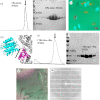Crystals of TELSAM-target protein fusions that exhibit minimal crystal contacts and lack direct inter-TELSAM contacts
- PMID: 35232248
- PMCID: PMC8889177
- DOI: 10.1098/rsob.210271
Crystals of TELSAM-target protein fusions that exhibit minimal crystal contacts and lack direct inter-TELSAM contacts
Abstract
While conducting pilot studies into the usefulness of fusion to TELSAM polymers as a potential protein crystallization strategy, we observed novel properties in crystals of two TELSAM-target protein fusions, as follows. (i) A TELSAM-target protein fusion can crystallize more rapidly and with greater propensity than the same target protein alone. (ii) TELSAM-target protein fusions can be crystallized at low protein concentrations. This unprecedented observation suggests a route to crystallize proteins that can only be produced in microgram amounts. (iii) The TELSAM polymers themselves need not directly contact one another in the crystal lattice in order to form well-diffracting crystals. This novel observation is important because it suggests that TELSAM may be able to crystallize target proteins too large to allow direct inter-polymer contacts. (iv) Flexible TELSAM-target protein linkers can allow target proteins to find productive binding modes against the TELSAM polymer. (v) TELSAM polymers can adjust their helical rise to allow fused target proteins to make productive crystal contacts. (vi). Fusion to TELSAM polymers can stabilize weak inter-target protein crystal contacts. We report features of these TELSAM-target protein crystal structures and outline future work needed to validate TELSAM as a crystallization chaperone and determine best practices for its use.
Keywords: TELSAM; X-ray crystallography; covalent protein crystallization chaperone; polymer-forming protein crystallization chaperone; protein crystallization method; protein polymer.
Conflict of interest statement
We declare we have no competing interests
Figures





Similar articles
-
Fusion crystallization reveals the behavior of both the 1TEL crystallization chaperone and the TNK1 UBA domain.Structure. 2023 Dec 7;31(12):1589-1603.e6. doi: 10.1016/j.str.2023.09.001. Epub 2023 Sep 29. Structure. 2023. PMID: 37776857 Free PMC article.
-
Fusion crystallization reveals the behavior of both the 1TEL crystallization chaperone and the TNK1 UBA domain.bioRxiv [Preprint]. 2023 Jun 14:2023.06.14.544429. doi: 10.1101/2023.06.14.544429. bioRxiv. 2023. Update in: Structure. 2023 Dec 7;31(12):1589-1603.e6. doi: 10.1016/j.str.2023.09.001. PMID: 37398013 Free PMC article. Updated. Preprint.
-
Decreasing the flexibility of the TELSAM-target protein linker and omitting the cleavable fusion tag improves crystal order and diffraction limits.bioRxiv [Preprint]. 2023 May 15:2023.05.12.540586. doi: 10.1101/2023.05.12.540586. bioRxiv. 2023. PMID: 37293010 Free PMC article. Preprint.
-
Crystal structures of MBP fusion proteins.Protein Sci. 2016 Mar;25(3):559-71. doi: 10.1002/pro.2863. Epub 2016 Jan 9. Protein Sci. 2016. PMID: 26682969 Free PMC article. Review.
-
New concepts and aids to facilitate crystallization.Curr Opin Struct Biol. 2013 Jun;23(3):409-16. doi: 10.1016/j.sbi.2013.03.003. Epub 2013 Apr 8. Curr Opin Struct Biol. 2013. PMID: 23578532 Review.
Cited by
-
Fusion crystallization reveals the behavior of both the 1TEL crystallization chaperone and the TNK1 UBA domain.Structure. 2023 Dec 7;31(12):1589-1603.e6. doi: 10.1016/j.str.2023.09.001. Epub 2023 Sep 29. Structure. 2023. PMID: 37776857 Free PMC article.
-
High-resolution structures of the SARS-CoV-2 N7-methyltransferase inform therapeutic development.Nat Struct Mol Biol. 2022 Sep;29(9):850-853. doi: 10.1038/s41594-022-00828-1. Epub 2022 Sep 8. Nat Struct Mol Biol. 2022. PMID: 36075969 Free PMC article.
-
Structures of SARS-CoV-2 N7-methyltransferase with DOT1L and PRMT7 inhibitors provide a platform for new antivirals.PLoS Pathog. 2023 Jul 31;19(7):e1011546. doi: 10.1371/journal.ppat.1011546. eCollection 2023 Jul. PLoS Pathog. 2023. PMID: 37523415 Free PMC article.
-
Increasing the bulk of the 1TEL-target linker and retaining the 10×His tag in a 1TEL-CMG2-vWa construct improves crystal order and diffraction limits.Acta Crystallogr D Struct Biol. 2023 Oct 1;79(Pt 10):925-943. doi: 10.1107/S2059798323007246. Epub 2023 Sep 25. Acta Crystallogr D Struct Biol. 2023. PMID: 37747038 Free PMC article.
-
Fusion crystallization reveals the behavior of both the 1TEL crystallization chaperone and the TNK1 UBA domain.bioRxiv [Preprint]. 2023 Jun 14:2023.06.14.544429. doi: 10.1101/2023.06.14.544429. bioRxiv. 2023. Update in: Structure. 2023 Dec 7;31(12):1589-1603.e6. doi: 10.1016/j.str.2023.09.001. PMID: 37398013 Free PMC article. Updated. Preprint.
References
Publication types
MeSH terms
Substances
Grants and funding
LinkOut - more resources
Full Text Sources

